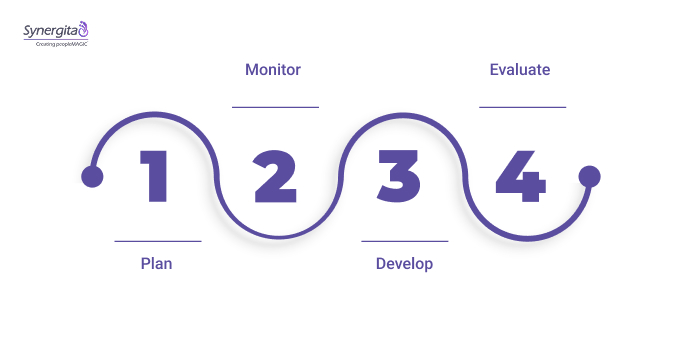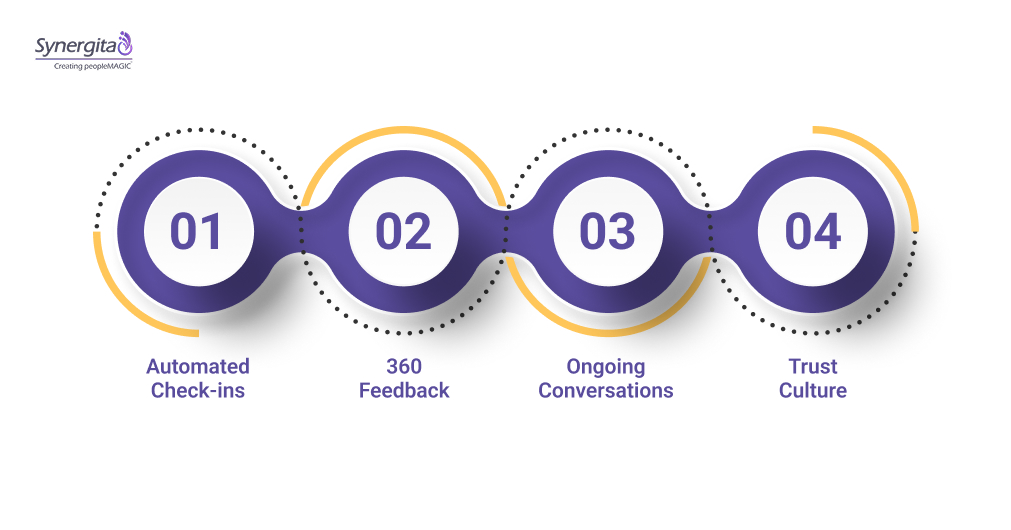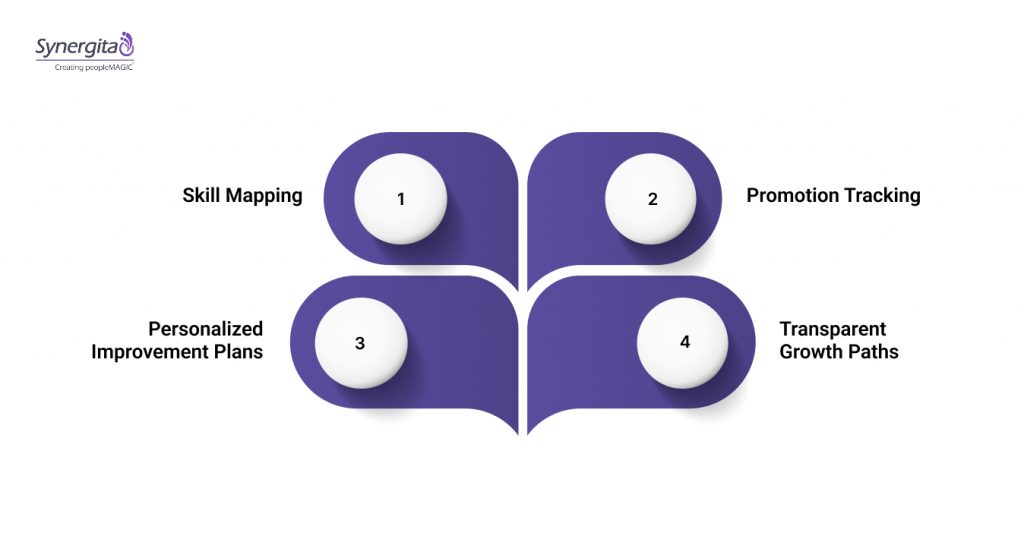Could managing your team’s performance actually ease their workload and increase their satisfaction? Using the right performance management approaches, performance management moves beyond stress and confusion to become a catalyst for clear goals, motivated teams, and strong results.
Yet, for many, the experience is quite different: disconnected reviews, unclear objectives, and slow or insufficient feedback that leave employees feeling frustrated and disengaged.
If your team is struggling with unclear goals, late feedback, or unfair evaluations, this is a common challenge many face.
In this blog, you’ll find actionable strategies to help managers continuously support their teams, sustain engagement, and make performance management a true game-changer year-round.
Key Takeaways
- Performance management is a continuous process that aligns individual goals with company objectives to drive real results.
- Clear goal-setting, regular check-ins, and ongoing feedback keep teams motivated and focused throughout the year.
- Traditional annual reviews fall short; continuous conversations and data-driven insights create fairer, more effective evaluations.
- Integrated technology that connects with everyday tools reduces admin work and supports seamless performance tracking.
- Empowering managers with real-time dashboards and automated workflows fosters a culture of trust, transparency, and growth.
- Rethinking performance management with Synergita transforms your workforce into a strategic advantage for sustained success.
What is performance management?
Performance management isn’t just a one-time event—it’s an ongoing process that connects your team’s goals with your company’s bigger mission to deliver real results. It brings together clear goal-setting, timely feedback, and fair evaluations to keep everyone focused and motivated.
A strong performance management system helps managers and employees stay aligned with real-time progress updates, regular check-ins, and transparent growth plans. This way, accountability and engagement go hand in hand, while bias in evaluations gets minimized.
Why Most Performance Management Efforts Miss the Mark
When performance management falls short, frustration and stalled growth follow. Those yearly reviews and outdated goals aren’t cutting it nowadays. If your business waits too long to adjust or teams aren’t working together, you risk losing both speed and top talent.
Traditional Approaches Just Don’t Cut It Anymore
The real point isn’t what performance management means—it’s how you do it. The best teams keep the conversation going, track progress in real time, and use data to keep things fair. By ditching old-fashioned methods, companies create clearer goals, motivated teams, and fair evaluations that help the business and employees grow.
The Real Issue: How You Manage Performance Matters
It’s not about what performance management is—it’s about how you do it. The best teams focus on ongoing conversations, real-time tracking, and using data to remove bias.
What Winning Performance Management Looks Like Today
- Clear goals linked directly to the company’s mission
- Continuous, meaningful check-ins—not once-a-year reviews
- Data-driven insights to make fairer decisions
- Transparent paths for career growth and development
When these pieces click, performance management transforms from a dreaded task into a powerful driver of engagement and results.
How Integrated Performance Management Fixes Common Challenges
Effective performance management requires a unified framework that brings together goal alignment, continuous feedback, unbiased evaluations, and career growth—all supported by technology that fits seamlessly into your team’s workflow.
Core Processes: Plan, Monitor, Develop, Evaluate

Performance management is an ongoing process that aligns individual goals with your company’s mission to drive results. It centers around four key stages to keep teams focused and growing.
1. Plan
Set clear, measurable goals aligned with organizational objectives. Involving employees in planning ensures goals are realistic and meaningful.
2. Monitor
Track progress regularly through ongoing check-ins. This helps identify challenges early and keeps performance on track.
3. Develop
Focus on employee growth by recommending training and coaching based on individual needs and aspirations.
4. Evaluate
Review performance using data and feedback from multiple sources for fair and transparent assessments. This builds trust and supports informed decisions.
Together, these stages make performance management a continuous journey to boost engagement and success.
Goal-Setting and Alignment That Works
Many organizations set goals, but the real challenge is getting everyone on the same page. That’s where things get tricky.
For example, your marketing team might be all about building brand awareness, while sales is focused on hitting short-term revenue targets. When teams pull in different directions like this, the overall impact can get lost.
That’s where a visual, real-time goal-mapping system—like Synergita’s goal cascade—really comes in handy. It helps by:
- Linking each person’s goals straight to their team and company objectives
- Giving everyone a clear view of how their work makes a difference in the bigger picture
So, a sales rep knows exactly how her targets feed into team quotas and company revenue goals, and an engineer can see how delivering key projects pushes innovation forward.
On top of that, AI-powered tools take the stress out of goal-setting by:
- Helping you set ambitious but doable targets based on past results and industry trends
- Automatically flagging any misaligned goals, so teams stay coordinated and focused
With these tools, managers and employees can easily set smart goals, keep their eyes on what matters, and work better together for real results.
Real-Time Feedback, Not Once-A-Year Reviews
Waiting for annual reviews often means course corrections come too late, causing missed growth opportunities. Continuous, real-time feedback keeps teams engaged, motivated, and on track throughout the year.
Key benefits include:

- Automated reminders that encourage regular check-ins, making performance conversations part of everyday work
- 360-degree feedback from managers, peers, and collaborators for a fuller, fairer view of performance
- Ongoing conversations about progress and challenges instead of just at review time
- Building a culture of trust and transparency where employees feel heard and empowered
Shifting from annual reviews to ongoing feedback turns performance management into a continuous, positive force that drives real development and stronger engagement.
Fair, Bias-Free Evaluations That Build Confidence
Let’s be honest—bias and unclear criteria quickly destroy trust in performance reviews. When employees feel judged unfairly, they lose motivation fast.
Studies show most evaluations rely heavily on a manager’s observations (67%) and performance ratings (54%), both subjective and prone to bias. That’s why fairer, more objective evaluation processes are essential to ensure accuracy and build trust.
Effective performance evaluation systems offer:
- Customizable appraisal workflows that fit your unique organization
- Normalization features to ensure fairness and consistency
- Multirater reviews provide a holistic, balanced view of employee performance.
- Credible and transparent assessments that employees can trust
Career Growth Paths That Retain Your Best Talent

High-potential employees want clear career progression. Without it, they often seek growth opportunities elsewhere.
Skill Mapping
Identify strengths and areas for improvement to guide development.
Promotion Tracking
Monitor and reward employee growth through promotions.
Personalized Improvement Plans
Create tailored plans based on individual goals to support growth.
Transparent Growth Paths
Offer clear, aligned career paths that match employee aspirations and keep them engaged.
Technology That Works for Your Team
To make performance management truly effective, the right technology needs to fit seamlessly into your team’s daily routine. The table below highlights essential aspects that help streamline processes, keep everyone connected, and reduce administrative hassle—empowering your team to focus on growth and success.
| Feature | Description | Example |
| Integration with tools like Jira, Slack, and Microsoft Teams | Connects performance management with everyday tools to make goal updates and feedback part of the daily routine. | A manager can recognize achievements directly in Slack or track milestones in Jira without switching platforms. |
| HRIS synchronization for a single source of truth | Ensures that employee records, including roles and reporting lines, are always current across all systems. | When an employee changes roles, their goals and workflows automatically update. |
| Cloud-based platform with real-time dashboards | Provides instant access to performance data and progress from anywhere via the cloud. | Managers can identify struggling goals early and support the employee, while employees see their progress instantly. |
| Mobile access for managers and employees | Allows updating goals and providing feedback on the go from any device. | Managers can review performance during travel; employees can update goals from their phones. |
| Reduced administrative overhead through automation | Automates reminders and workflows to minimize paperwork and streamline performance management. | Automated reminders ensure check-ins aren’t missed; customizable templates save time for meaningful growth conversations. |
Culture and Manager Enablement: The Power of Contextual Feedback
Performance management tools are helpful, but they’re not the real game-changer—managers are. When managers give timely, relevant, and personalized feedback, employee performance really takes off.
Giving managers easy-to-use dashboards that bring together key insights and goals makes having meaningful development conversations simple and stress-free. With automated reminders and customizable workflows, continuous coaching becomes a natural part of the daily routine, creating a culture built on transparency, trust, and growth.
What This Means for Your Business
By rethinking performance management with Synergita, you’re not just improving processes—you’re turning your people into a strategic advantage.
- Faster Goal Achievement: Clear goals and continuous tracking help teams stay focused and deliver results more quickly.
- Increased Engagement: Regular feedback replaces surprise reviews, building trust and keeping employees motivated.
- Higher Retention: Transparent growth paths attract and retain top talent, reducing turnover and preserving knowledge.
- Better Decisions: Real-time data removes bias, allowing managers to make fair, informed choices about development and rewards.
Ready to Transform Your Performance Management?
It’s time to align your teams, empower your managers, and unlock your workforce’s full potential with Synergita. Our modern, integrated performance management solution helps you move beyond traditional processes.
By setting clear goals, providing timely feedback, and encouraging ongoing coaching, Synergita transforms scattered efforts into focused, measurable success. Your teams gain clarity and confidence, while managers get the tools to lead effectively.
Take the first step toward a more engaged and productive workforce today. Start your free trial of Synergita and see how streamlined performance management drives real results.
Want more winning strategies? Access our other resources for actionable tips, real-life examples, and proven techniques to keep your team performing at its best.
FAQs
1. How can integrated systems reduce bias in performance evaluations?
By using multirater feedback, normalization features, and data-driven assessments, integrated systems promote fairness and transparency.
2. Why is visual goal mapping important for team alignment?
It helps everyone see how individual efforts contribute to team and company objectives, improving clarity and collaboration across departments.
3. How can organizations make performance check-ins less burdensome?
Automated nudges, easy-to-use dashboards, and embedding feedback in daily workflows encourage regular, meaningful conversations without extra hassle.
4. What role does performance management play in employee career growth?
It provides clear growth paths, personalized development plans, and promotion tracking, helping retain top talent and reducing turnover.

